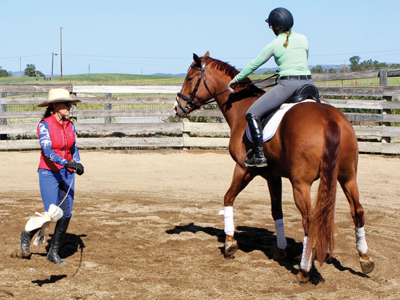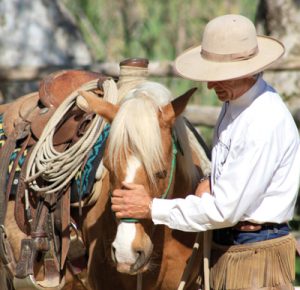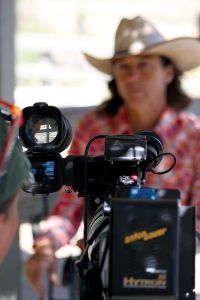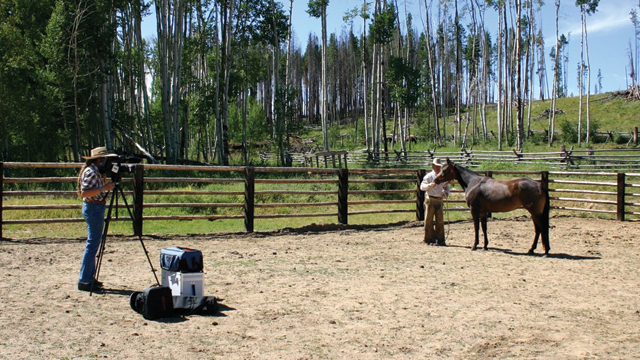The 50th issue of The Horseman’s Gazette is about to be released. Wait…what is The Horseman’s Gazette? You haven’t heard? No, it’s not a printed publication; it’s an ongoing video series focusing on the same practical, unembellished, and outstanding horsemanship, and presented by many of the same trusted horse folk, you find in Eclectic Horseman magazine. And is now available in both DVD and streaming formats!
From Buck Brannaman to Wendy Murdoch, Bryan Neubert to Martin Black…Ellen Eckstein, Lee Smith, Joe Wolter, Buster McLaury, and on and on—you won’t find a larger more comprehensive collection of video insights and lessons from a wider range of professionals anywhere. And, this distinctive horsemanship video encyclopedia just keeps growing.
It is called the Gazette because it is published four times a year and annual subscriptions can be purchased so they arrive regularly in your mailbox just like copies of your favorite periodical. Individual issues also can be ordered from the backlist.

This year marks the ninth that the Gazette has been produced by Eclectic Horseman magazine. The idea for this unique video spin-off from the magazine was the idea of Eclectic Horseman owner and editor, Emily Kitching.
“We had finished a video for Martin Black,” Emily says. “We had been hired to edit it—it was filmed by a professional videographer. When I sat down to look at the footage I was disappointed in how much the so-called expert had missed because he was an expert in videography but not in horses.”
Emily edited and re-worked that first video project to get it right, but it left her thinking that she might be better suited to take on both the editing and the video work in the field.
“I know horses and I’ve shot photos of them for years, so I understand timing and position,” Emily explains. “So, we started filming and editing horsemanship DVDs for other people. Once I had experience doing that, I really started to realize the awesome power of video and how well it compliments what we’re trying to do with the print publication—which is, educate people’s eye as well as give them things to do with their horses.”
Emily describes The Horseman’s Gazette as “a quarterly educational video series.” Whenever she discusses the magazine or the Gazette, Emily is quick to point out how central education is to both. It is Emily’s own compulsive quest to get better with horses, especially her horse Belich, that has overflowed into her livelihood. The result is a career based on sharing the best horsemanship guidance available with other horse lovers full-time.
Another way Emily describes the Gazette to folks is to say, “Imagine the pages of the magazine come to life on video.”

Each issue runs between two and two and a half hours and includes multiple segments with a variety of horse folk. The segments provide a range of approaches to topics. In some, a guest horseman will work a horse and discuss the process with the viewer as it unfolds, sharing what he or she sees taking place, what he or she is doing, what challenges are presented by the horse, and how things turn out. In others, a presenter works with a student and a horse so the viewer essentially gets to sit in on a lesson. Others are interviews with capable horse people who speak on a range of topics from wrecks to their own approaches to some aspect of horse work.
“It might take a long time to get some nice changes in a horse,” Emily admits of videoing the horse work in the field. “I edit sparingly on the Gazette pieces because I want people to see in real time the time that it takes for these things to transpire. So, I don’t cut out the middle part where a horse is having to work at something because the people who are interested in the Gazette often are the kind of people who are interested in seeing the process.”
As mentioned above, the Gazette was designed to be a growing base of educational knowledge, and with 30 volumes now available and many upcoming segments already “in the can,” Emily’s special project is enjoying both longevity and increasing interest.
“It’s a large body of work, and we still have all of the back issues except the first two available,” she says. “Once they go out of stock, we’re not reprinting them at this point.”
For Emily, the chance to load up the truck with her equipment (and often her daughter, Sydney, as well) and travel to learn from so many great horse people who generously allow her to come and visit and put them in front of the camera is a unique circumstance that she is eager to share.
“The opportunity to see people teach outside of a clinic format is really interesting,” Emily says. “A lot of times these men or women are riding their own horses at their own facilities and it’s on their own time. So, they’re not bound by any time constraints and they’re working at their own pace to demonstrate something, or expose a horse to something, or to accomplish a task, so there’s not any pressure on anybody.”

One recent contributor to The Horseman’s Gazette is Chris Sobenes. Chris is based in Oak View, California, and she trains horses and teaches horsemanship. (www.chrissobenes.com) Chris has a segment in Issue No. 28 of the Gazette that shows how to start a novice adult rider with good horsemanship concepts in a safe and fun way.
“I just love how The Horseman’s Gazette dovetails with the Eclectic Horseman magazine!” Chris says. “If you have read an article in the magazine you will likely be able to find a corresponding video to reinforce your learning experience. No other magazine does this and I think it is an invaluable tool to invest in both mediums. I think of this video series as a tool of the trade. Participating in the making of The Horseman’s Gazette has helped me hone my skills as a teacher and helped me to have a greater understanding of how to explain some of the concepts of horsemanship using visual and written forms.”
Emily believes that providing an opportunity to see a great variety of horse people share their knowledge in the video series is a great way to stir up ideas and to inspire people to improve their horsemanship.
“Tom Dorrance encouraged people to go watch anyone that they possibly could because you can learn something from everybody by watching what they do,” Emily says. “How the information is conveyed in these videos is dependant upon the source that’s providing it. So, like Windy Murdoch, when she does a piece, she is typically teaching another student. So you’re getting to watch someone’s lesson and see her help that rider make changes and you can see the change in the horse and the rider. If it’s somebody like Martin Black or Peter Campbell or Buster McLaury, they’re with their horses and they’re demonstrating.
“We’ve done quite a few segments with Bryan Neubert. He’s got lots of young horses to work with. When he is home in the winter or early spring, we’ll go to his place and film for a day or two and he’ll work all the horses that he would be working if he were there without us. He’ll bring the yearlings in and introduce them to being led. Or, we did one where it was the first time a colt was away from its mom. We did some segments on what he would expect with a really young horse with a few rides introducing a stop and a turnaround versus a horse with two or three years of riding working again on the stop or the turnaround so that you can see the progression and what he would expect at different moments from a horse with that similar experience level. It’s really a wide variety of content.
“I’m trying to give people the tools and the information that they need to develop their own horsemanship—not to be like anybody else, or to do what somebody else is doing, but for them, themselves, to put in the work to develop what it means for their own development.”
Emily stays on the lookout for new contributors. The process of deciding if a new teacher or trainer is a good fit for the series requires time, effort, and consideration.
“If it’s new people I haven’t worked with before, I like to go watch them teach for a few days,” Emily says. “Like last summer, I’d never seen Tom Curtin teach and I’d had people tell me quite often that I needed to go check him out for the magazine and for the Gazette. So, I went and watched him do a colt starting clinic and watched him teach for a couple of days. I really liked what I saw, and one afternoon we shot several segments there at the ranch where he was teaching the clinic.”
Feedback from subscribers to both the magazine and the Gazette is appreciated. Like people suggesting possibilities for new horsemen to include, Emily considers all the opinions that come in.
“Some of the feedback that I get,” she says, “is that people who live in areas where they don’t have clinicians coming to them, and they don’t have somebody local that they ride with—they maybe get to one clinic a year—the Gazette is their lifeline for improvement and for having something to strive for or challenge them, or to keep them from getting bored or stuck. It’s not just that they have a problem that they need solved, except for the problem of not having a clear path where they want to go or what they want to do.”
Perhaps the best way to wrap up an introduction to The Gazette is simply to share a quote from a longtime subscriber.
“I am so grateful that Eclectic Horseman magazine and the Gazette video series are available,” says Lisa Capaldini. “I find that they both express a very specific philosophy of horsemanship that is pretty hard to find elsewhere, namely that riders have a responsibility to be good partners to their horses. Because horses are so connected to their emotions, good riding and horse work means ALWAYS taking the horse’s state of mind/heart in mind. Some ‘experts’ reduce this to minimizing reactivity/ensuring obedience but I think it’s way more complicated than that, and, requires the rider to be emotionally tuned in to themselves. Since I started riding 12 years ago I have been happily obsessed with horses and trying to improve my horsemanship (being with horses) and trying to improve the technical parts of my riding. The Eclectic Horsemanship approach keeps those two linked.
“Another feature I really appreciate is how humble the EH experts are—there’s a saying about doctors (I’m one!) that over time, every doctor becomes either cynical or humble (hopefully the latter) and I find myself remembering how humble your teachers are when I’m having a horse problem. And your experts also teach “beginner’s mind,” an approach that encourages patience and openness rather than quick solutions.
“A final thought—the more I ride and hang around horses the MORE I’m getting out of the EH articles and videos—there’s always more to learn, methods to refine, strategies to discard or modify—this journey with horses has a lot to do with learning and respect and your magazine and video models them both superbly!”
Watch short excerpts of all previous issues of The Horseman’s Gazette.


